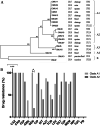Carbapenem-resistant Enterobacter cloacae complex in a tertiary Hospital in Northeast China, 2010-2019
- PMID: 34174823
- PMCID: PMC8235818
- DOI: 10.1186/s12879-021-06250-0
Carbapenem-resistant Enterobacter cloacae complex in a tertiary Hospital in Northeast China, 2010-2019
Abstract
Background: Carbapenem-resistant Enterobacter cloacae complex (CREC) is a new emerging threat to global public health. The objective of the study was to investigate the clinical characteristics and molecular epidemiology of CREC infections in the medical center of northeast China.
Methods: Twenty-nine patients were infected/colonized with CREC during a ten-year period (2010-2019) by WHONET analysis. Antibiotic susceptibilities were tested with VITEK 2 and micro broth dilution method (for polymyxin B and tigecycline). Carbapenemase encoding genes, β-lactamase genes, and seven housekeeping genes for MLST were amplified and sequenced for 18 cryopreserved CREC isolates. Maximum likelihood phylogenetic tree was built with the concentrated sequences to show the relatedness between the 18 isolates.
Results: There was a rapid increase in CREC detection rate during the ten-year period, reaching 8.11% in 2018 and 6.48% in 2019. The resistance rate of CREC isolates to imipenem and meropenem were 100.0 and 77.8%, however, they showed high sensitivity to tigecycline, polymyxin B and amikacin. The 30-day crude mortality of CREC infection was 17.4%, indicating that it may be a low-virulence bacterium. Furthermore, molecular epidemiology revealed that ST93 was the predominant sequence type followed by ST171 and ST145, with NDM-1 and NDM-5 as the main carbapenemase-encoding genes. Moreover, E. hormaechei subsp. steigerwaltii and E. hormaechei subsp. oharae were the main species, which showed different resistance patterns.
Conclusion: Rising detection rate of CREC was observed in a tertiary hospital, which showed heterogeneity in drug resistance patterns, resistance genes, and MLST types. Effective infection prevention and control measures should be taken to reduce the spread of CREC.
Keywords: Carbapenem-resistant; Enterobacter cloacae complex; Molecular analyses; NDM; ST93.
Conflict of interest statement
No competing interests relevant to this article exist.
Figures


Similar articles
-
Molecular eidemiology of carbapenem-resistant Enterobacter cloacae complex in a tertiary hospital in Shandong, China.BMC Microbiol. 2023 Jul 5;23(1):177. doi: 10.1186/s12866-023-02913-x. BMC Microbiol. 2023. PMID: 37407923 Free PMC article.
-
Molecular epidemiological analysis and risk factors for acquisition of carbapenemase-producing Enterobacter cloacae complex in a Japanese university hospital.Antimicrob Resist Infect Control. 2019 Jul 24;8:126. doi: 10.1186/s13756-019-0578-3. eCollection 2019. Antimicrob Resist Infect Control. 2019. PMID: 31367347 Free PMC article.
-
Molecular characterization of metallo-β-lactamase- producing carbapenem-resistant Enterobacter cloacae complex isolated in Heilongjiang Province of China.BMC Infect Dis. 2020 Jan 31;20(1):94. doi: 10.1186/s12879-020-4768-7. BMC Infect Dis. 2020. PMID: 32005138 Free PMC article.
-
Evidence from a New York City hospital of rising incidence of genetically diverse carbapenem-resistant Enterobacter cloacae and dominance of ST171, 2007-14.J Antimicrob Chemother. 2016 Aug;71(8):2351-3. doi: 10.1093/jac/dkw132. Epub 2016 Apr 26. J Antimicrob Chemother. 2016. PMID: 27118776 Free PMC article. Review. No abstract available.
-
Antibiotic resistance in Enterobacter hormaechei.Int J Antimicrob Agents. 2022 Oct;60(4):106650. doi: 10.1016/j.ijantimicag.2022.106650. Epub 2022 Aug 4. Int J Antimicrob Agents. 2022. PMID: 35934231 Review.
Cited by
-
Molecular Epidemiology, Risk Factors and Clinical Outcomes of Carbapenem-Nonsusceptible Enterobacter cloacae Complex Infections in a Taiwan University Hospital.Pathogens. 2022 Jan 25;11(2):151. doi: 10.3390/pathogens11020151. Pathogens. 2022. PMID: 35215096 Free PMC article.
-
Frequent convergence of mcr-9 and carbapenemase genes in Enterobacter cloacae complex driven by epidemic plasmids and host incompatibility.Emerg Microbes Infect. 2022 Dec;11(1):1959-1972. doi: 10.1080/22221751.2022.2103456. Emerg Microbes Infect. 2022. PMID: 35848148 Free PMC article.
-
Genetic Characterization of Enterobacter hormaechei Co-Harboring bla NDM-1 and mcr-9 Causing Upper Respiratory Tract Infection.Infect Drug Resist. 2022 Aug 31;15:5035-5042. doi: 10.2147/IDR.S367073. eCollection 2022. Infect Drug Resist. 2022. PMID: 36068833 Free PMC article.
-
Molecular eidemiology of carbapenem-resistant Enterobacter cloacae complex in a tertiary hospital in Shandong, China.BMC Microbiol. 2023 Jul 5;23(1):177. doi: 10.1186/s12866-023-02913-x. BMC Microbiol. 2023. PMID: 37407923 Free PMC article.
-
First documentation of a clinical multidrug-resistant Enterobacter chuandaensis ST2493 isolate co-harboring blaNDM-1 and two blaKPC-2 bearing plasmids.Sci Rep. 2024 Nov 5;14(1):26817. doi: 10.1038/s41598-024-78163-2. Sci Rep. 2024. PMID: 39500966 Free PMC article.
References
-
- Zhang Y, Wang Q, Yin Y, Chen H, Jin L, Gu B, Xie L, Yang C, Ma X, Li H, Li W, Zhang X, Liao K, Man S, Wang S, Wen H, Li B, Guo Z, Tian J, Pei F, Liu L, Zhang L, Zou C, Hu T, Cai J, Yang H, Huang J, Jia X, Huang W, Cao B, Wang H. Epidemiology of Carbapenem-resistant Enterobacteriaceae infections: report from the China CRE network. Antimicrob Agents Chemother. 2018;62(2):e01882–e01817. doi: 10.1128/AAC.01882-17. - DOI - PMC - PubMed
Publication types
MeSH terms
Substances
LinkOut - more resources
Full Text Sources

